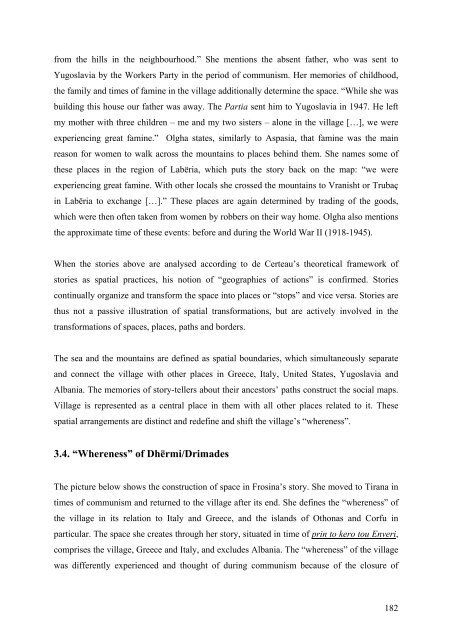university of nova gorica graduate school contested spaces and ...
university of nova gorica graduate school contested spaces and ...
university of nova gorica graduate school contested spaces and ...
Create successful ePaper yourself
Turn your PDF publications into a flip-book with our unique Google optimized e-Paper software.
from the hills in the neighbourhood.” She mentions the absent father, who was sent to<br />
Yugoslavia by the Workers Party in the period <strong>of</strong> communism. Her memories <strong>of</strong> childhood,<br />
the family <strong>and</strong> times <strong>of</strong> famine in the village additionally determine the space. “While she was<br />
building this house our father was away. The Partia sent him to Yugoslavia in 1947. He left<br />
my mother with three children – me <strong>and</strong> my two sisters – alone in the village […], we were<br />
experiencing great famine.” Olgha states, similarly to Aspasia, that famine was the main<br />
reason for women to walk across the mountains to places behind them. She names some <strong>of</strong><br />
these places in the region <strong>of</strong> Labëria, which puts the story back on the map: “we were<br />
experiencing great famine. With other locals she crossed the mountains to Vranisht or Trubaç<br />
in Labëria to exchange […].” These places are again determined by trading <strong>of</strong> the goods,<br />
which were then <strong>of</strong>ten taken from women by robbers on their way home. Olgha also mentions<br />
the approximate time <strong>of</strong> these events: before <strong>and</strong> during the World War II (1918-1945).<br />
When the stories above are analysed according to de Certeau’s theoretical framework <strong>of</strong><br />
stories as spatial practices, his notion <strong>of</strong> “geographies <strong>of</strong> actions” is confirmed. Stories<br />
continually organize <strong>and</strong> transform the space into places or “stops” <strong>and</strong> vice versa. Stories are<br />
thus not a passive illustration <strong>of</strong> spatial transformations, but are actively involved in the<br />
transformations <strong>of</strong> <strong>spaces</strong>, places, paths <strong>and</strong> borders.<br />
The sea <strong>and</strong> the mountains are defined as spatial boundaries, which simultaneously separate<br />
<strong>and</strong> connect the village with other places in Greece, Italy, United States, Yugoslavia <strong>and</strong><br />
Albania. The memories <strong>of</strong> story-tellers about their ancestors’ paths construct the social maps.<br />
Village is represented as a central place in them with all other places related to it. These<br />
spatial arrangements are distinct <strong>and</strong> redefine <strong>and</strong> shift the village’s “whereness”.<br />
3.4. “Whereness” <strong>of</strong> Dhërmi/Drimades<br />
The picture below shows the construction <strong>of</strong> space in Frosina’s story. She moved to Tirana in<br />
times <strong>of</strong> communism <strong>and</strong> returned to the village after its end. She defines the “whereness” <strong>of</strong><br />
the village in its relation to Italy <strong>and</strong> Greece, <strong>and</strong> the isl<strong>and</strong>s <strong>of</strong> Othonas <strong>and</strong> Corfu in<br />
particular. The space she creates through her story, situated in time <strong>of</strong> prin to kero tou Enveri,<br />
comprises the village, Greece <strong>and</strong> Italy, <strong>and</strong> excludes Albania. The “whereness” <strong>of</strong> the village<br />
was differently experienced <strong>and</strong> thought <strong>of</strong> during communism because <strong>of</strong> the closure <strong>of</strong><br />
182

















